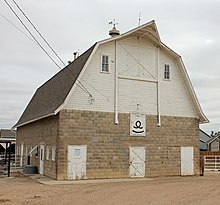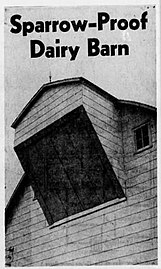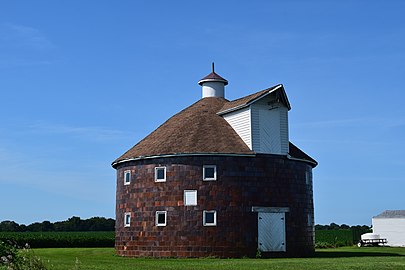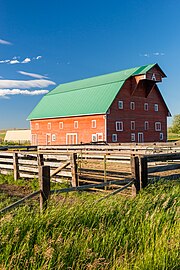Hay hood

Ahay hoodis a roof extension which projects from the ridge of abarnroof, usually at the top of agable.It provides shelter over a window or door used for passing hay into the attic or loft of the barn; it may hold a pulley for hoisting hay orhay balesup to the loft, or a fork orgrappleand track system (orhay carrier) where hay can be lifted and then moved throughout the barn. A barn may have the ridge beam extended past the wall with a lifting mechanism but no hay hood.[1]
This simplest hay hood includes a tapered roof extension providing some protection from the weather. A non-tapered extension provides more protection. A hay hood with partial or full walls underneath the extension on two sides is more protective, while an extension with three sides, allowing hay to be brought into the barn only through its "floor" keeps virtually all rain or snow out of the barn.[1]
A hay hood can be built on a barn with any roof type. The type of hood is generally determined by the weather of a particular region. A barn in a semi-arid region may have no hood or just a simple pointed one. A barn in a region with frequent driving rain may have a completely enclosed hay hood. This is common in an area of western Oregon in the United States, centered on the town ofMonroein theWillamette Valley,where it is called ahay cupola.Mostgambrel roofedbarns in the western U.S. have pointed hay hoods.[1]Hay hoods have been built onround barns.[2][a]
It may also be known as ahay bonnet,[1]hay gable,[1]widow's peak,[b]crow's beak,[3]orhanging gable.[4]
To prevent small gaps around the closed doors at the beam penetration that would allow birds to enter the barn, one farmer inReasnor, Iowa,designed a hay hood with a "bunker door" that when closed, was an angled floor on the hay hood, completely enclosing the hood and keeping birds such assparrowsandpigeonsout of the barn.[5]
Other uses
[edit]
A littlecatshead(alternativelycat's headorcats head) is anarchitectural featurecommonly found on multi-storied mills, agricultural buildings, and factories, composed of a small extension protruding from thegable endof a largerroof.
Agrist millwith a single main roof and catsheads at each end vaguely resembles acat's head in sillohuette, with the catsheads forming the "ears" of the imaginary feline; this may be the origin of the name.
Catsheads originally existed to protect the ropes and pulleys associated with lifting equipment (such as theblock and tacklerigs used to shift multi-ton milling equipment and the simple wheelpulleysused to liftfodderinto haylofts) from ice and the corrosion caused by rain. In driest climates, if they had an opening to the building which lacked a door or window, this may have been adequate to prevent the goods from deteriorating.
Adding the protective catshead to the gable end of a roofline makesroofingtasks such as taking and removing tiles/panels simpler, and was an economy as obviates theflashing (weatherproofing)of a completely separate roof.
Whimsical architectural styles (such asNew World Queen Anne Revival architecture) may also sport catsheads as non-functional decorative features.
Gallery
[edit]-
Fully enclosed hay hood on theCheadle BarninBenton County, Oregon,U.S., listed on theNational Register of Historic Places
-
Fully enclosed hay hood on a barn inHeiligenstadt in OberfrankeninUpper Franconia, Bavaria,Germany
-
Pointed hay hood on a round-roofed barn inAlberta, Canada
-
Bottom-doored hay hood inReasnor, Iowa,U.S.
-
Hay hood on a round barn (Virginia Tillery Round BarninGreene County, Illinois)
-
Barn with hay hood inWallowa County,Oregon
Notes
[edit]- ^A hay hood on a round barn does not meet the standard definition since the roof of a round barn has no ridge, therefore the no ridge extension. On a round barn, a hay hood is more of adormerbut serves the same function of protecting a loft opening.
- ^This term is used by contemporary manufacturers of vintage-looking barns for a purely decorative element, apparently borrowing the name fromwidow's peakand/orwidow's cap.
References
[edit]- ^abcdeFrancaviglia, Richard V. (1972)."Western American Barns: Architectural Form and Climatic Considerations".Yearbook of the Association of Pacific Coast Geographers.3 4:153–60.doi:10.1353/pcg.1972.0010.JSTOR24041292.S2CID128474828.RetrievedApril 23,2022.
- ^David Kammer (August 2003)."National Register of Historic Places Registration: Ojo Caliente Hot Springs Round Barn".National Park Service.RetrievedDecember 7,2016.withfour photos
- ^Johnson, Samantha (June 10, 2019)."Old Barns in America: A Field Guide".hobbyfarms.com.RetrievedApril 23,2022.
- ^Cyril M. Harris (1998).American Architecture: An Illustrated Encyclopedia.W. W. Norton & Company. p. 169.ISBN978-0-393-73103-3.OCLC1005157692.
- ^"Sparrow-proof dairy barn".The Des Moines Register.Des Moines, Iowa. February 6, 1949. p. 115.RetrievedApril 23,2022– viaNewspapers.com.







